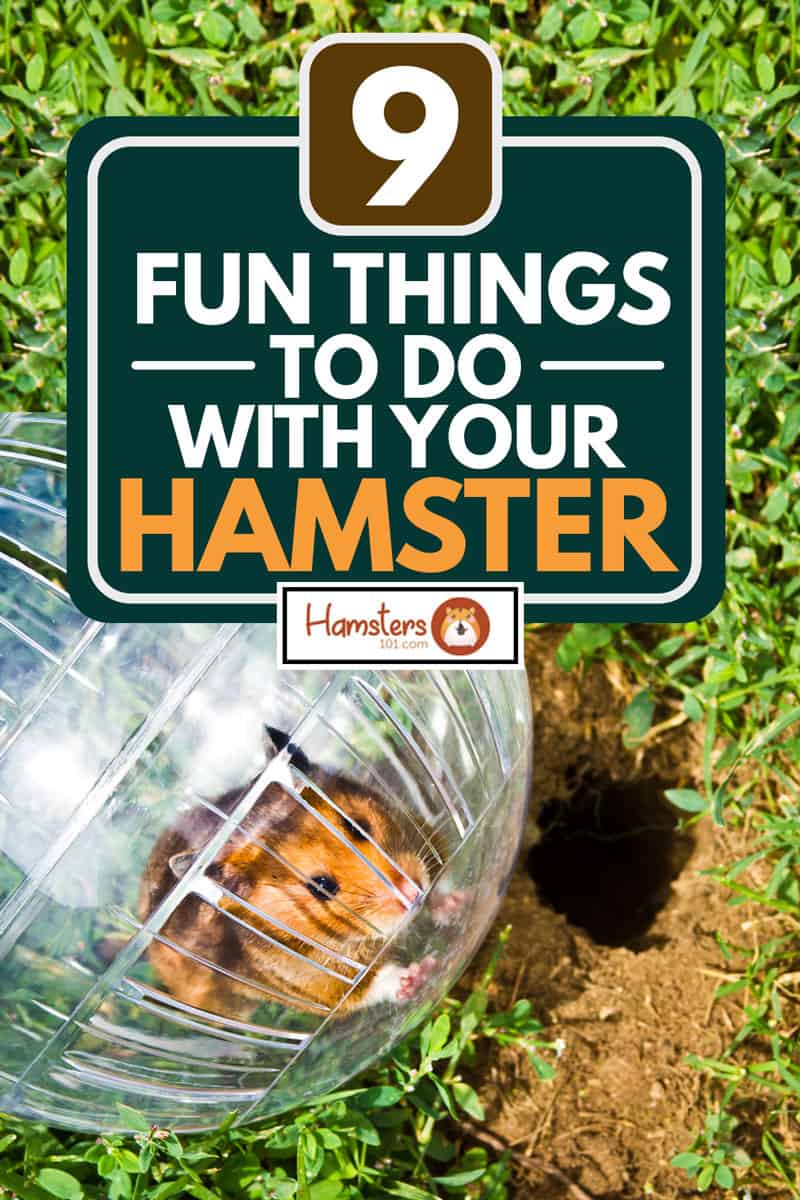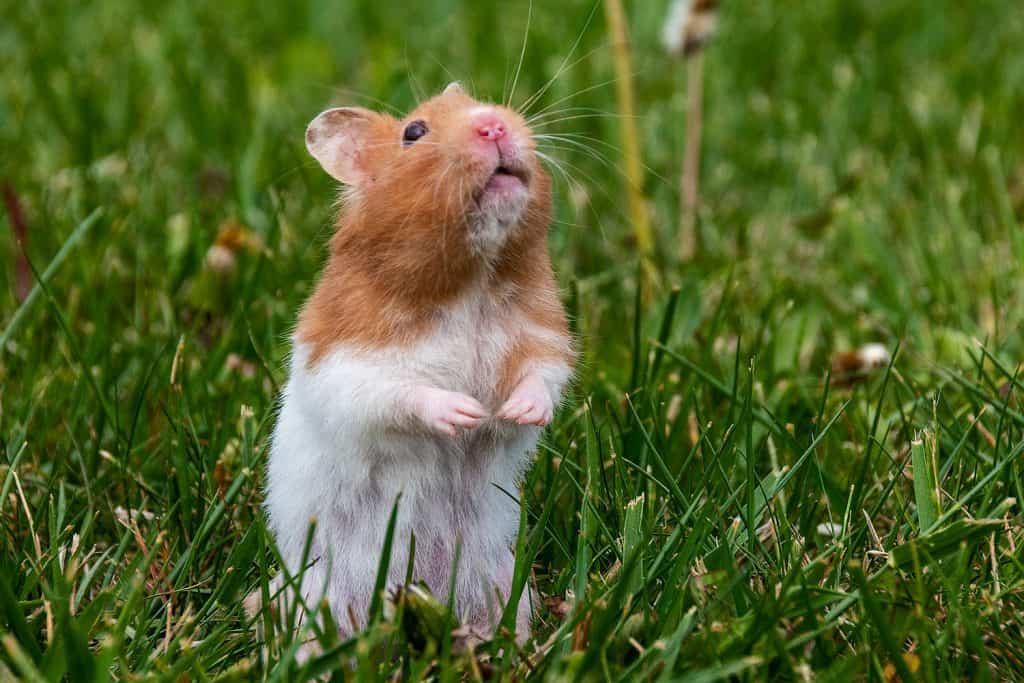Hamsters are small pets that are usually confined to their cages. People might think that it isn't possible to have very much fun with a hamster, but that's not the case! Hamsters are social creatures that like interaction with their owner, and you can do many fun things together. We will give you several ideas to have fun with your small friend and give some ideas on cage decorations too.
There are many things you can do to have fun with your hamster. Some of these are fun for the hamster while you can have fun watching. Others are more fun for you and your hamster together.
- Running wheel
- Hamster ball
- Teach tricks
- Climbing strings or rope
- Photoshoot
- Run in the grass
- Maze
- Hide and seek
- Cage accessories
These are some ideas to get you started having fun with your hamster. There are games you can play and tricks you can teach. There are decorations you can buy or make that will add some life to your pet's cage. You can take interesting and funny pictures with your hamster to show your friends. Keep reading , as we discuss the ways you can play with your hamster and the best time to engage your hamster in these activities.

1. Running Wheels
Hamsters need daily exercise, and providing them with a running wheel inside the cage will allow them to be active when they want to be.
Wild Harvest Metal Activity Wheel
2. Hamster Ball
A hamster ball is an option that allows you to have some fun with your pet outside of the cage. Hamsters might only need 20 to 30-minutes of exercise each day and shouldn't exercise for more than an hour. Always supervise your hamster if it is in a running ball outside of the cage. They can get seriously hurt or die if not supervised. The hamster does not know how to direct the ball, so a wide-open space is preferable.
When using a hamster ball, the hamster could roll off the edge of a table or surface. For this reason, you should only use the hamster ball on the ground far away from any stairs. You should monitor your hamster to make sure it does not run into walls, furniture, and hard surfaces. Even if this does not hurt the hamster, running into things can be very stressful. Hamster balls are one way for you and your hamster to have fun, but you must be careful and attentive.
Kaytee Run About Ball
Click here to see more at Amazon.
3. Teach Hamster Tricks
You can teach a hamster to do tricks like you can a pet dog. You will need treats that your hamster likes to begin the training sessions. Some of the tricks you can teach are to stand, jump, and roll over. Hold a treat above the hamster's head just out of reach and say the command, "Stand!" When the hamster stands, give praise and provide the treat. Eventually, the hamster will learn the command and respond without seeing the treat first.
Once your hamster has learned the stand command, you can move onto jump. Start by telling the hamster to stand. When the hamster stands, hold a treat a little above the hamster's head. Move the treat up and down and say the command, "Jump!" Once the hamster jumps to get the treat, give praise, and provide the treat.

Another easy trick is to teach your hamster to roll over. You can do this by placing a seed or a treat on the hamster's back. Then say, "Roll over!" If the hamster rolls, give praise and provide the treat.
When your hamster has mastered these tricks, you can move on to more complicated tricks. You can teach your hamster to come to you when you call its name. Some other tricks include jumping through hoops and spinning around while standing. The motivation is the treat. You train the hamster by encouraging a behavior with the treat while saying the command. After a few times, the hamster learns the command without needing to see the treat.
4. Climbing Strings Or Rope
Hamsters really enjoy climbing and could benefit from having sturdy ropes or strings in their cages. You can tie some string or rope to parts of the cage, and that can encourage your hamster to climb. There are also climbing toys that can be purchased from different retailers. Many of these climbing toys are marketed towards all small animals, including birds, rats, gerbils, and hamsters.
Cotton Rope Nets For Hamsters And Small Animals
Click here to see more at Amazon.
5. Photoshoot
You probably think a photoshoot isn't very much fun for a hamster, but it is when treats are involved! While your hamster gets a treat, you can get some cute and adorable photos; fun for you too! You can make your own photo stand-in for your small hamster by drawing your own design on a piece of cardboard (a board with a hole where someone puts their face in the hole to create a funny photo). Then you can hold a treat on the other side of the cardboard to encourage your hamster to put its face in the hole.
6. Run In The Grass
Hamsters enjoy being outside and in the grass, but there are some precautions you should take before bringing your small pet outside:
- First, you need to make sure the temperature is not too hot or cold. Hamsters prefer mild temperatures and can get overheated in direct sunshine or frostbit in cold temperatures.
- The grass is often sprayed with chemicals that will be very bad for your hamster to consume. Only bring your hamster out to the grass if you know the grass is untreated.
- Hamsters can be very fast, so it is best to create an enclosure to keep your hamster nearby. Other predators outside, including neighbor cats, would be very excited to find a meal with your beloved pet hamster.

Hamsters do not need outdoor time, so if you cannot follow all of the precautions, it is best to keep your hamster indoors.
7. Maze
You can make a maze and other homemade hamster toys with used cardboard from grocery store goods. Not only does a maze provide viewing pleasure for you, but it gives your hamster a brain-stimulating exercise. A tissue box is a perfect size to cut open and transform into a play place for your hamster. You'll need the tissue box, scissors, glue (non-toxic), and some paint (non-toxic) for decorating. Check out the instructions for how to make a hamster maze. Alternatively, you can purchase some intriguing hamster mazes and toys.
Hamster Wooden Maze by Wontee
8. Hide And Seek
The last section discussed one way to make a cardboard maze, and this could be used to play hide and seek with your hamster. You can also use props to create other diversions or new hiding places to make this a fun game. Your hamster has a strong sense of smell and should be able to find the treat if you hide it somewhere in the cage. This stimulates the hamster brain as they actively search for the treat. Use a timer for your entertainment to see if your hamster improves his seeking skills over time.
9. Cage Accessories
How can you make your hamster's cage more fun? You can make your own hamster toys and cage decorations by reusing some things that would end up in your trash or recycling bin (please, no plastics!) --as we've previously discussed, and you've just seen in the YouTube video above. You can connect these creations to pre-existing cage playgrounds or hidey houses to keep your hamster's cage entertaining.
Alternatively, manufactured mazes, hidey houses, and playgrounds keep your hamter entertained while at home in her cage. You can even buy expansion sets to build beyond the limits of the cage to lead your hamster down an adventure. Use your creativity, and your available space to create hours of fun together.
Check out these cool glow in the dark hamster cages and accessories.
How Many Treats Can I Feed My Hamster?
Many of these fun activities involve giving little treats to your hamster. While it is true that hamsters do not overeat, it is possible for them to develop diabetes if they are not meeting their nutritional requirements. Since hamsters will not overeat, giving them too many treats will spoil their dinner. Many hamster treats on the market are not made for a nutritionally balanced diet. It is recommended that you limit treats to less than 10% of the hamster's total diet.
Kaytee Treat Stick With Superfoods
Click here to see more at Amazon.
You can find some treats that are nutritious for the hamster, but you should still limit the overall number of treats. Check out "How To Make Hamster Treats At Home" to learn how to make your own hamster treats.
Can You Play With Your Hamster During The Day?
Hamsters are often referred to as nocturnal animals, but that is not true. While hamsters do sleep during the day, most hamster breeds are active during dawn and dusk. In the wild, hamsters need to stay clear of predators. They do this by foraging for food during dawn and dusk. This is the same explanation for why hamsters do not see very well during daylight. Animals that are active during dawn and dusk are called crepuscular animals.
You should not play with your hamster during the day until you observe your pet's natural sleep routine. If you disturb your hamster too much during sleep hours, then he will be more likely to bite you when you try to play. Hamsters are like humans and need a certain amount of sleep according to a steady, regular sleep schedule. Observe your hamster to find what time of the day is most active and try to arrange your hamster play sessions around these active periods.
How Often Should You Play With Your Hamster?
You should give your hamster some time to get used to its cage and home before handling. You can introduce your hand to the cage gradually and allow your hamster to become more comfortable with the smell of your hand and your presence. Once you start handling your hamster, observe how much she likes to be handled. If your hamster is friendly, then you should consider playing once a day outside of the cage with your hamster. If your hamster is more shy or scared of being handled, then you could reduce the handling time to two or three times per week.
What Does It Mean When A Hamster Licks You?
Hamsters in the wild will lick stones for salt or sodium. In this case, the hamster is licking your hands for salt or sodium. Some people may think the hamster is licking as a sign of affection, but there is no evidence that supports that claim. Your hamster licking your skin could be a sign of a sodium deficiency. There are salt lick products you can purchase for your hamster's cage. This will allow them to get the salt they need that otherwise would be foraged in the wild.
In Closing
Hamsters are small animals, but they are not boring. You can create your own cage art or toys for your hamster pet. You can teach a hamster tricks and play with her outside of the cage. Making sure your hamster has the ability to get exercise is important. A hamster wheel is a good way to get exercise without your supervision, but a hamster ball will require your attentive focus. Make sure to play with your hamster near dawn or dusk so they can get enough sleep during daytime hours.







![A cute little hamster lying inside his pink cage, Can You Take A Hamster On A Plane? [And How To]](https://hamsters101.com/wp-content/uploads/2021/08/A-cute-little-hamster-lying-inside-his-pink-cage-300x200.jpg)
